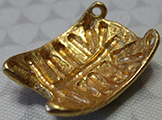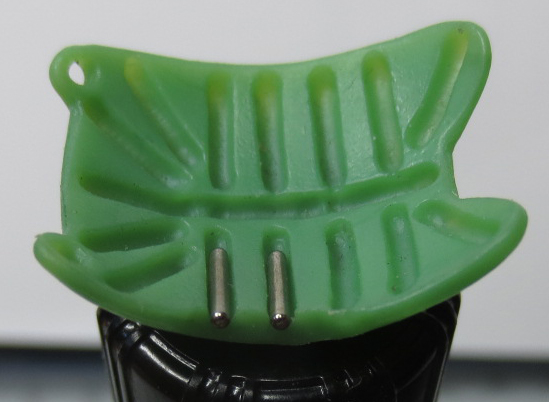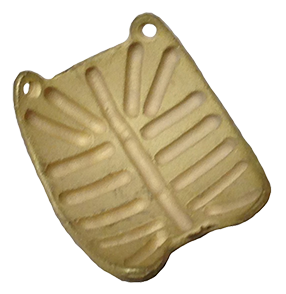 The USC#9 plaque originated in the late 1980s as this very primitive prototype. It was conceived as a geometrically more reproducible alternative to manually fabricated designs of that era such as this plaque from Philadelphia which consisted of seeds glued to the face of a plastic shell backed with a lead foil.
The USC#9 plaque originated in the late 1980s as this very primitive prototype. It was conceived as a geometrically more reproducible alternative to manually fabricated designs of that era such as this plaque from Philadelphia which consisted of seeds glued to the face of a plastic shell backed with a lead foil. The USC#9 would be cast from gold rather than use hazardous lead for posterior shielding and it would use cyanoacrylate to mount the seeds rather than dental acrylic, making it much easier to recover the seeds.
The USC#9 would be cast from gold rather than use hazardous lead for posterior shielding and it would use cyanoacrylate to mount the seeds rather than dental acrylic, making it much easier to recover the seeds.
Both of these plaques were dosimetrically minimalist designs in the sense that they made no attempt to shield the patient from any forward or laterally directed radiation emitted from the plaque, and unlike the alternative COMS designs, these plaques were thinner and the seeds not embedded in a costly single use silicone carrier. The dominant absorption mechanism for low energy I-125 radiation is the photoelectric effect for which the COMS silicone carrier is significantly more attenuating than water owing to the higher effective atomic number (compared to water) of the carrier material which is mostly silicon. This inhomogeneity surrounding the seeds adds complexity to dosimetry calculations. The minimalist nature of these early plaques was all well and good because brachytherapy planning systems in the 1980s could not readily account for seed collimation and other inhomogeneities on such a small physical scale.
 In 1993 the USC#9 design was refined and polished, the crude rectangular gluing slots were manually rounded to better match the cylindrical shape of I-125 seeds in order to provide a more conformal surface-to-surface fit for cyanoacrylate bonding of the seeds to the plaque face. The depth of the slots of the 1993 revision were less than half the diameter of an I-125 seed, preserving the plaque's dosimetrically minimalist design. Slot collimation calculations, introduced around 1997, are not applicable to the USC#9. The 1993 version was also cast a bit thinner than the 1989 model in order to make it lighter and easier to implant.
In 1993 the USC#9 design was refined and polished, the crude rectangular gluing slots were manually rounded to better match the cylindrical shape of I-125 seeds in order to provide a more conformal surface-to-surface fit for cyanoacrylate bonding of the seeds to the plaque face. The depth of the slots of the 1993 revision were less than half the diameter of an I-125 seed, preserving the plaque's dosimetrically minimalist design. Slot collimation calculations, introduced around 1997, are not applicable to the USC#9. The 1993 version was also cast a bit thinner than the 1989 model in order to make it lighter and easier to implant.
 The 1993 casting of the USC #9 plaque predates the incorporation of Eye Physics, LLC by more than a decade. However, a few plaques of this design were purchased via direct arrangement between the jeweler who manufactured the plaques for USC and various interested parties.
The 1993 casting of the USC #9 plaque predates the incorporation of Eye Physics, LLC by more than a decade. However, a few plaques of this design were purchased via direct arrangement between the jeweler who manufactured the plaques for USC and various interested parties.
 In the mid 1990s Astrahan used a Dremel tool to experimentally modify a 1989 casting of the USC#9 with deeper slots to provide an even more secure cyanoacrylate bonding surface and observed that the modification also resulted in some collimation of laterally directed radiation emitted from the plaque. This is the home-made experimental model that eventually became a workhorse at USC and inspired the research effort that led to the plaque described by Astrahan et al. in 1997 and a decade later inspired the EP917.
In the mid 1990s Astrahan used a Dremel tool to experimentally modify a 1989 casting of the USC#9 with deeper slots to provide an even more secure cyanoacrylate bonding surface and observed that the modification also resulted in some collimation of laterally directed radiation emitted from the plaque. This is the home-made experimental model that eventually became a workhorse at USC and inspired the research effort that led to the plaque described by Astrahan et al. in 1997 and a decade later inspired the EP917.

All Eye Physics plaques begin as wax, resin or brass prototypes from which molds are created. The final gold castings are made from these molds. This is a wax EP917 prototype with a section carved away to illustrate how seeds reside in the slots.
Below is an EP917 that has just come from casting. After casting, the residual plaster dust is removed in a tumbler and the plaque is hand polished to achieve its final appearance.

In 2007 Eye Physics acquired the distribution rights for the plaques produced by the jeweler for USC and commissioned a new casting of the USC#9 pattern with deeper slots. Decayed seeds were used to manually test the shape and depth of the slots. The 2007 revision of the USC#9 for Eye Physics was designated as the model EP917.
These are the molds that have been used since 1989 to cast the USC#9 and EP917 plaques.